updated: 1-25-2019
What sort of plant is Rhodiola rosea?
Rhodiola rosea is a fascinating plant. It’s a perennial, flowering plant that’s often referred to as golden root. This herb has received a good deal of attention as it appears to be a safe and effective medicinal plant.
People around the world use Rhodiola to help with their mood, stress, fatigue and anxiety. We’ll get into the details of these health benefits in just a moment. First, let’s cover some background information for Rhodiola rosae.
In the middle of this article, I review a handful of respected brands of Rhodiola supplements.
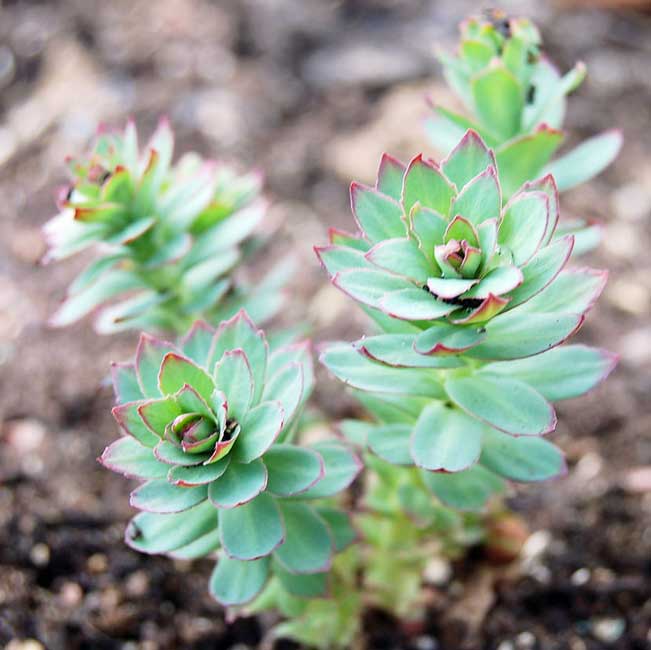
Photo: Amazonia Exotics U.K [CC BY-SA 4.0]
Rhodiola rosea sprouting new growth during the spring
Where does Rhodiola live?
Rhodiola rosea is a tough and rugged plant. It grows comfortably on mountain tops and along windy, sea cliffs. The plant is native to Siberia and the Tian Shan mountain range in northwestern China. You can now find Rhodiola growing throughout the mountains of Central Asia, Europe, the Rocky Mountains of North America and in much of the Arctic.
Cultural history of the Rhodiola plant
Rhodiola rosea was brought to the world’s attention in 77 AD.
Discorides, the well-respected Greek physician and botanist, wrote about Rhodiola in his classic book, De Materia Medica. In the book, Discorides describes various medicinal applications for Rhodiola. (Mell, 1938)
De Materia Medica was written between 50-70 A.D. To this day, this text remains the best historical source for the type of medicine that was practiced by Greeks and Romans.
Discorides referred to the plant as Rodia riza. The plant received its current name, Rhodiola rosea, in the 18th century when the plant was renamed by Carolus Linnaeus, the famous Swiss taxonomist. Linnaeus choose the name rosea because of the rose-like fragrance that emitted from a freshly cut stem. In his writings, Linnaeus described the use of Rhodiola for ‘headaches and hernias’.
Sidenote: We now know the rose-like fragrance is due to Geraniol essential oil, which is found in the Rhodiola rosea stem.
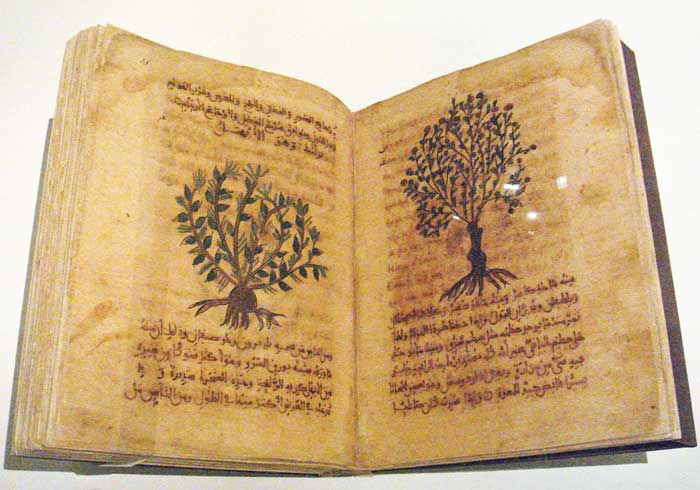
A copy of De Materia Medica.
Written in 77 A.D., this famous Greek text first described the medicinal properties of Rhodiola.
During the past 300 years, use of Rhodiola became integrated into the traditional medicines of Russia, Sweden, Norway and Iceland. This makes sense, since this hardy stonecrop plant grows comfortably in these sub-arctic environments.
The Vikings were very fond of the herb. They used Rhodiola to maintain their stamina and stay healthy during their cold, northern winters.
Tibetans regarded Rhodiola to be an effective remedy for respiratory infections. Chinese emperors routinely sent overland expeditions into Siberia to collect Rhodiola. The Chinese first referred to Rhodiola as the golden root.
Mongolians have used Rhodiola for centuries. Similar to the Vikings, these rugged people relied on the plant to help them endure their cold, sub-arctic weather. (Dharmananda, 2001)
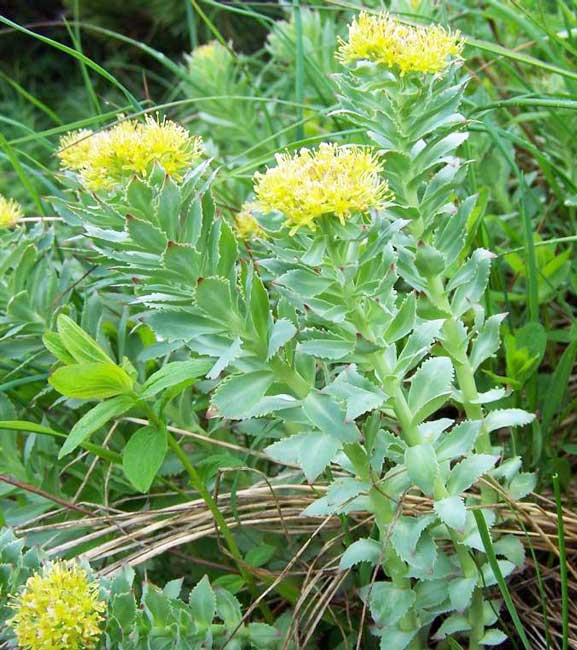
Photo: Opioła Jerzy (CC-BY-SA-3.0)
Rhodiola rosea growing on a mountain in Poland.
Factors to consider when taking Rhodiola
Andrew Weil, M.D. wrote an article recommending a standardized Rhodiola rosea root extract that contains 2-3% rosavin and 0.8-1% salidroside. A standardized extract is an extract that features a concentrated amount of the biologically active chemicals from the plant. As we discussed earlier, salidroside and rosavin are 2 of the active chemicals found in Rhodiola.
If you find your Rhodiola extract is over-stimulating you, try taking it earlier in the day. This way you won’t interfere with your sleep.
Drug-Herb interactions
When taking a herbal supplement it is wise to learn if there are any herb-drug interactions. Sometimes, by taking a prescribed medication and a medicinal plant at the same time, we create a harmful reaction in our body. It’s good to be informed on the subject. Here is what we know about Rhodiola.
- Experiments have shown that Rhodiola can interfere with the CYP3A4 enzyme and P-glycoprotein activity. Take caution if combining Rhodiola with another drug that uses those entities to metabolize drugs. (Hellum, 2010)
- As discussed earlier, Rhodiola also has MAO (monoamine oxidase) activity. Take caution if you are using medication that causes shifts in MAO activity. (van Diermen, 2009)
When in doubt, consult with your physician. Physicians studied MAO and CYP activity in medical school. It’s their job to know whether your prescribed medication effects these processes.
Possible side effects
In general, there are relatively few side effects observed with Rhodiola. (Parnossian, 2010)
Take caution if you are combining Rhodiola with another anti-depressant medication. There has been one report of a ‘fast and irregular heart beat’ reported with a patient who combined Rhodiola and a SSRI drug treatment. (McGovern, 2010)
Rhodiola rosea reviews
Gaia Herbs: Rhodiola Rosea
Gaia is one of our favorite herb growers. Their headquarters is a large organic farm in the Blue Ridge Mountains of North Carolina. Gaia Herbs performs DNA bar-coding and phyto-chemical analyses for each bottle of Rhodiola that they sell. These tests ensure you get an active version of the correct plant in your supplement.
Gaia sources their Rhodiola rosea from the pristine alpine meadows of Siberia. Their Rhodiola is wild harvested, as opposed to being grown on a farm. Gaia tests each bottle of Rhodiola to ensure the full spectrum of compounds are present in each capsule. This plant material is then lab tested for purity.
Now: Rhodiola rosae 60 capsules, 500mg.
NOW is a large, well-respected company in the health industry. The company was founded by the Richards family in 1968. The Richards family remains in control of the business today. NOW began in Illinois and remains based there today. Despite their size, these folks have a reputation for selling quality supplements and making environmentally friendly business practices. They product test all of their supplements to ensure a potent form of each plant is in each bottle.
NOW Rhodiola rosae is a standardized extract. These capsules contain a minimum of 3% total rosavins and a minimum of 1% salidrosides. As discussed earlier, rosavins and salidrosides are the active components of Rhodiola rosae.
Herb Pharm Rhodiola Root Extract – 4 Ounce
Herb Pharm is a beloved medicinal plant company for many herbalists. These folks are located in the Applegate Valley of southern Oregon. I studied Biology as an undergrad at a college near the Applegate Valley. It’s a beautiful part of the country. Herb Pharm has been producing high quality plant extracts for 35 years. They’ve earned a devout following, due in large part to the quality of their herb manufacturing. At EthnoHerbalist, we support Herb Pharm because of their commitment to potency and purity. They use HPTLC (High Performance Thin Layer Chromatography) to verify the contents of each plant extract.
This 4 ounce bottle is a tincture of Rhodiola plant. The plant matter has been extracted with organic cane alcohol. Users commonly use 2-3 full droppers per day.
The health benefits of Rhodiola rosea
Sometimes, I run into a problem as I begin researching the health benefits of a medicinal plant. I realize that no human, clinical trials have been performed for that plant.
This makes it very challenging to discuss the safety and effectiveness of the plant.
Fortunately, this is not the case with Rhodiola rosea.
Scientists have been researching Rhodiola rosea for hundreds of years. Many clinical trials with human patients have been published. These reports explore the safety and health benefits of Rhodiola rosae. Because of these reports, we have the luxury of observing how humans are effected by Rhodiola.
A number of clinical trials suggest that the use of Rhodiola extract produces the following positive effects:
- improve mood (Darbinyan, 2007)
- increase attention (Shevtsov, 2003; Schutgens, 2009)
- relieve fatigue (Olsson, 2009; Spasov, 2000)
- relieve mild to moderate depression (Darbinyan, 2007; Mao, 2015)
- help with general anxiety (Bystritsky, 2008)
Let’s examine a few of these reports below.
Rhodiola and Depression
Depression is one of the most common and challenging psychological issues today. It’s estimated that 16% of the population will experience depression in their lifetime.
And when depression arrives, it does not come alone. Depression has a high co-morbidity rate. This means that depression is often accompanied by other chronic diseases. (Kessler, 2003)
How do we define depression?
Depression is a persistent feeling of sadness and a general lack of interest or excitement with one’s life. Symptoms of depression can include poor sleeping, lost appetite, low energy levels and drops in self-esteem.

photo: Wellcome Images (CC BY 4.0)
An 1892 sketch of a depressed and manic gentleman.
How do we treat depression?
In my opinion, the first line of defense against depression should be therapy and creating positive changes in one’s life. If you feel you’ve exhausted those options and your depression remains a problem, then you may want to explore medication or supplements.
Depression can be caused by an imbalance of biochemistry in one’s body. Ideally, a drug or supplement will correct that imbalance.
If you approach your physician and request medication for your depression – you will likely be prescribed a SSRI.
SSRI stands for ‘selective serotonin re-uptake inhibitors’. These are the most commonly prescribed drugs for the treatment of depression. You might recognize some of these names: Paxil, Zoloft, Prozac, Celexa. These are examples of SSRI drugs.
While some patients do report improvements with a SSRI, many patients do not. Numerous studies show that treatment with SSRI drugs is not significantly better than a placebo control. (Kirsch, 2014)
This means – you could take a tic-tac candy and create a similar improvement in depression.
Furthermore, treatment with a SSRI is often associated with negative side effects. Some of the more common side effects are weight gain, nausea and sexual dysfunction.
Are there reasonable alternatives to SSRI drug treatment?
As you may imagine, many depressed individuals are searching for alternatives to SSRI drug therapy. Botanical supplements, such as St. John’s wort, are commonly used alternative options.
Multiple clinical reports suggest Rhodiola rosae is also a reasonable alternative for mild to moderate depression.
In certain clinical trials, biologists have demonstrated that use of Rhodiola can lessen the intensity of depression. Furthermore, the side effects of Rhodiola are only a fraction of the side effects observed with SSRI treatment. We’ll explore 2 of these trials below.
Trial 1
In Norway, a group of scientists performed a Phase III study to test both the safety and efficacy of Rhodiola rosea. Patients suffering from a current episode of mild to moderate depression were tested over a period of 6 weeks. The group included males and females aged 18-70 years old. Some patients received a placebo while others received Rhodiola root extract. On day 0 and day 42, the severity of depression was measured with a HAMD questionnaire.
The authors conclude that a Rhodiola dosage of 340-680 mg/day over a 6-week period produced a significant improvement in depression. Interestingly, no serious side effects were reported with the patients treated with Rhodiola. (Darbinyan, 2007).
Trial 2
Another group, working from the University of Pennsylvania, performed a similar clinical experiment, but they also included a SSRI comparison.
Scientists performed a 12 week trial with 57 human subjects. The patients received either a SSRI (Zoloft), Rhodiola rosae extract or else a placebo. Changes in depression were measured over time with the HAM-D, BDI and CGI/C tests. (Mao, 2016)
Although R. rosea produced slightly less anti-depressant effect versus Zoloft, Rhodiola also resulted in significantly fewer side effects and was better tolerated.
63% of patients on Zoloft reported side effects (nausea, sexual dysfunction), while only 30% of patients on Rhodiola reported side effects.
The authors conclude that, when compared to Zoloft, Rhodiola ‘may possess a more favorable risk to benefit ratio for individuals with mild to moderate depression’.
In summary…
More clinical work needs to be done on the subject. However, it appears Rhodiola may be a reasonable option for people suffering from mild to moderate depression. I think Rhodiola is especially appealing if you are depressed but cannot tolerate the side effects of traditional, anti-depressant drugs.
Early biological research on Rhodiola
Between the 18th and 19th century, numerous medicinal applications of Rhodiola rosae were outlined in scientific publications from Germany, the Soviet Union, Iceland and Norway. By the late 19th century, Rhodiola was well regarded as a brain tonic in France and used to battle headaches in Germany. (Darbinyan, 2000)
It should be noted, that in the past 100 years, Russia has led much of the research on this plant.
In traditional Russian medicine, Rhodiola is used to increase physical endurance and address fatigue, depression, stress and other symptoms of the nervous system. In the 1960s, Russian clinical work demonstrated the plant could reduce stress and act as a stimulant. Due to the strength of these studies, Rhodiola rosea was included in the Russian Pharmacopeia, 11th edition. (Saratikov, 1974)
Russian scientists identified salidroside as the active ingredient in the plant that delivered its anti-stress and stimulant properties. Russians botanists were also among the first to regard Rhodiola as a plant adaptogen. (Brekhman and Dardymov, 1969)
An adaptogen is defined as a natural substance thought to help our body adapt to stress and to normalize our physical state. Ginseng is often mentioned as a classic example of an adaptogen.
How does Rhodiola work in our body?
Throughout this article, we talk about the use of Rhodiola rosae root extract.
We will now describe:
- How this extract is created.
- What the extract contains.
- How the contents of this extract interact with our body.
How is Rhodiola rosea extract created?
Each supplement company or herbalist will create this extract slightly differently. However, here is a general protocol.
- Dig up the plant.
- Rinse off the dirt.
- Chop up the roots.
- Soak roots in a bottle filled with 40-70% alcohol, often in a 1:1 ratio.
- Allow the alcohol to extract the active chemical compounds from the root material.
- Filter out the root material. You have just created a basic Rhodiola tincture.
Alcohol is a solvent. This means it is capable of pulling chemical compounds out of the root and bringing them into the alcohol solution.
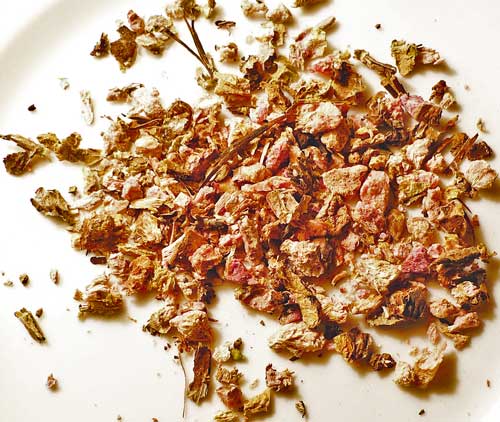
Photo: Badagnani (CC BY 3.0)
Chopped up Rhodiola rosea root material
What are the contents of this extract?
Reports demonstrate there are about 140 different Rhodiola chemicals present in a root extract. The active chemicals in this extract are classified within the following chemical groups: the monoterpene alcohols and the glycosides. (Heinrich, 2012)
Of those chemical groups the most important individual chemicals seem to be:
- salidroside
- rhodiolin
- rosin
- rosavin
- rosarin
- rosiridin
Biochemists and physicians have performed experiments on many of these isolated chemicals. Their data suggests that these are the main chemical compounds responsible for the health benefits of Rhodiola rosea. (topic reviewed in Panossian, 2010)
What are these active compounds doing for our body?
Scientists have demonstrated that Rhodiola rosea can help with fatigue, depression, anxiety and stress. (Panossian and Wikman, 2009)
That said, we are not entirely sure how the active chemicals listed above create these physiological effects. However, some preliminary experiments have been performed. The following experiments seek to explain the manner Rhodiola interacts with our body.
- Evidence suggests Rhodiola extract can effect our endocrine system via the HPA axis. The HPA axis is a feedback loop between the hypothalamus, pituitary and adrenal gland (see photo). Among other things, this axis regulates our stress response. Scientists show how Rhodiola rosea imparts an anti-stress effect on rats by balancing their HPA axis. (Xia, 2016) This would classify as an adaptogenic effect.
- Rhodiola extract appears to stimulate noradrenaline, serotonin, dopamine and acetycholine receptors in the brain. Changes in these receptor proteins, especially serotonin, will have an effect on our mood. (Brown, 2002)
- Rhodiola extract can inhibit monoamine oxidase enzymes. This would effect neurotransmitter levels in our brain, which would also effect our mood. (van Diermen, 2009)
- Another report shows Rhodiola extract can increase our natural endorphin levels while preventing additional stress-related endorphins. This could also generate adaptogen activity. (Khanum, 2005)
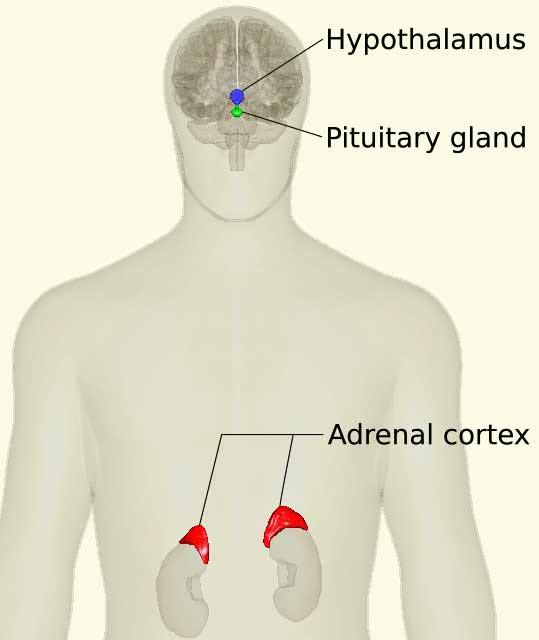
photo: Anatomography (CC BY-SA 2.1 jp)
Our HPA axis helps regulate our stress levels.
Data suggests Rhodiola rosea acts as an adaptogen by balancing our HPA axis. (Xia, 2016)
…an interesting thing about Rhodiola and photosynthesis
Rhodiola belongs in the Crassulaceae family of plants, a group also known as the stonecrops. The stonecrops have thick, succulent leaves and are famous for performing a clever form of photosynthesis.
Instead of regular photosynthesis, the stonecrops perform CAM photosynthesis.
Quick review of photosynthesis
During photosynthesis, plants take in carbon dioxide and sunlight and use them to create high energy sugars. Plants use these sugars as their source of fuel.
To make this all happen, most plants breathe in their carbon dioxide during the daytime while they are also absorbing energy from the sun.
Rhodiola throws in an additional trick.
To keep from drying out, Rhodiola only breathes in carbon dioxide during the nighttime. This prevents the hot sun from pulling moisture out of the plant as the plant is trying to breathe in the carbon dioxide.
Rhodiola then stores this carbon dioxide until daytime. When the sun comes up, the plant then uses the sun’s energy to convert the stored carbon dioxide into its high energy sugars.
This is a clever survival mechanism that keeps Rhodiola hydrated during the hot and dry arctic summers.
Summary of photosynthesis

Photo: By At09kg (CC BY-SA 3.0)
Rhodiola is clever enough to breathe in its carbon dioxide at night.
References
Brekhman, I. I., and I. V. Dardymov. “New substances of plant origin which increase nonspecific resistance.” Annual review of pharmacology 9.1 (1969): 419-430.
Brown, R. P., P. L. Gerbarg, and Z. Ramazanov. “Rhodiola rosea; a phytomedicinal overview. HerbalGram 56: 40–52.” (2002).
Bystritsky, Alexander, Lauren Kerwin, and Jamie D. Feusner. “A pilot study of Rhodiola rosea (Rhodax®) for generalized anxiety disorder (GAD).” The Journal of Alternative and Complementary Medicine 14.2 (2008): 175-180.
Darbinyan, V., et al. “Rhodiola rosea in stress induced fatigue—a double blind cross-over study of a standardized extract SHR-5 with a repeated low-dose regimen on the mental performance of healthy physicians during night duty.” Phytomedicine 7.5 (2000): 365-371.
Darbinyan, V., et al. “Clinical trial of Rhodiola rosea L. extract SHR-5 in the treatment of mild to moderate depression.” Nordic journal of psychiatry 61.5 (2007): 343-348.
Dharmananda, Subhuti. “Tibetan herbal medicine.” INTERNATIONAL JOURNAL OF ORIENTAL MEDICINE 26.1 (2001): 1-13.
Heinrich, Michael, et al. Fundamentals of pharmacognosy and phytotherapy. Elsevier Health Sciences, 2012.
Kessler, Ronald C., et al. “The epidemiology of major depressive disorder: results from the National Comorbidity Survey Replication (NCS-R).” Jama 289.23 (2003): 3095-3105.
Khanum, Farhath, Amarinder Singh Bawa, and Brahm Singh. “Rhodiola rosea reviews: a versatile adaptogen.” Comprehensive reviews in food science and food safety 4.3 (2005): 55-62.
Kirsch, Irving, et al. “Initial severity and antidepressant benefits: a meta-analysis of data submitted to the Food and Drug Administration.” PLoS Med 5.2 (2008): e45.
Mao, Jun J., et al. “Rhodiola rosea versus sertraline for major depressive disorder: A randomized placebo-controlled trial.” Phytomedicine 22.3 (2015): 394-399.
McGovern, E., and T. J. McDonnell. “Herbal medicine–sets the heart racing!.” Irish medical journal (2010).
Mell, C. D. “Dyes, tannins, perfumes, and medicines from Rhodiola rosea.” Textile Colorist 60.715 (1938): 483-4.
Olsson, Erik MG, Bo von Schéele, and Alexander G. Panossian. “A randomised, double-blind, placebo-controlled, parallel-group study of the standardised extract shr-5 of the roots of Rhodiola rosea in the treatment of subjects with stress-related fatigue.” Planta medica 75.02 (2009): 105-112.
Panossian, A., G. Wikman, and J. Sarris. “Rosenroot (Rhodiola rosea): traditional use, chemical composition, pharmacology and clinical efficacy.” Phytomedicine 17.7 (2010): 481-493.
Panossian, Alexander, and Georg Wikman. “Evidence-based efficacy of adaptogens in fatigue, and molecular mechanisms related to their stress-protective activity.” Current clinical pharmacology 4.3 (2009): 198-219.
Saratikov, A. S. “Golden root (Rhodiola rosea).” Russia: Tomsk (1974).
Schutgens, F. W. G., et al. “The influence of adaptogens on ultraweak biophoton emission: a pilot‐experiment.” Phytotherapy Research 23.8 (2009): 1103-1108.
Shevtsov, V. A., et al. “A randomized trial of two different doses of a SHR-5 Rhodiola rosea extract versus placebo and control of capacity for mental work.” Phytomedicine 10.2 (2003): 95-105.
Spasov, A. A., et al. “A double-blind, placebo-controlled pilot study of the stimulating and adaptogenic effect of Rhodiola rosea SHR-5 extract on the fatigue of students caused by stress during an examination period with a repeated low-dose regimen.” Phytomedicine 7.2 (2000): 85-89.
Van Diermen, Daphné, et al. “Monoamine oxidase inhibition by Rhodiola rosea L. roots.” Journal of ethnopharmacology 122.2 (2009): 397-401.
Xia, Nan, et al. “Schisandra chinensis and Rhodiola rosea exert an anti-stress effect on the HPA axis and reduce hypothalamic c-Fos expression in rats subjected to repeated stress.” Experimental and therapeutic medicine 11.1 (2016): 353-359.
Statements regarding the health supplements mentioned on this page have not been evaluated by the FDA. These products are not intended to diagnose, treat, cure, or prevent any disease. This page contains affiliate links and I will be compensated if you make a purchase after clicking on my links. Read more…



